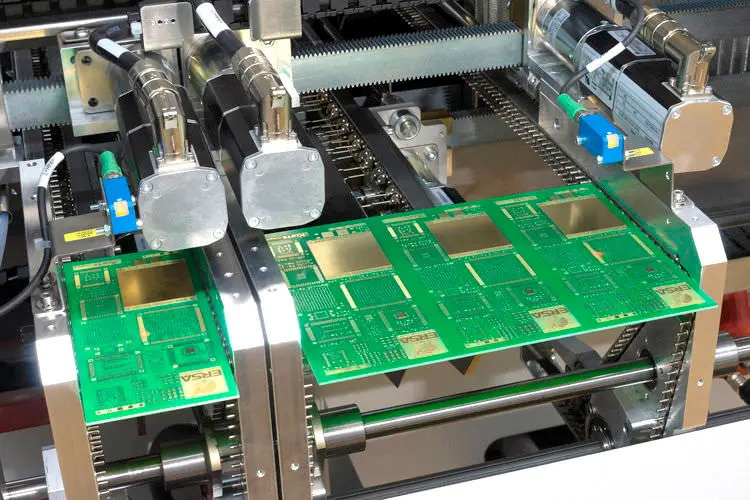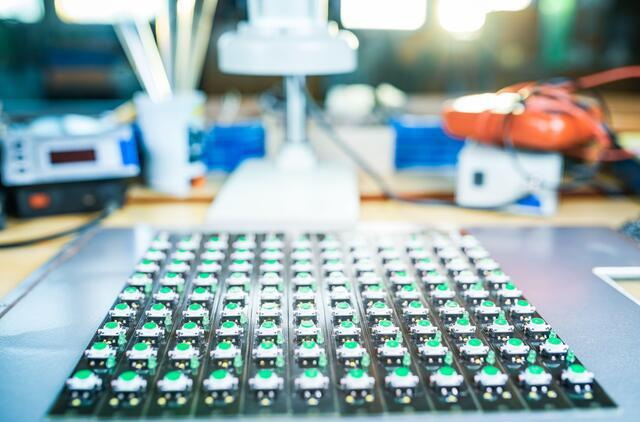Content Menu
● Understanding SMT and ASM Machines
● Key Strategies for Optimizing Your SMT Line
>> 1. Equipment Optimization
>> 2. Line Layout Optimization
>> 3. Process Improvements
>> 4. Automation Integration
● Additional Strategies for Enhanced Efficiency
>> Lean Manufacturing Principles
>> Supplier Relationships
>> Quality Control Measures
● Conclusion
● FAQ
>> 1. What is Surface Mount Technology (SMT)?
>> 2. How do ASM machines enhance SMT production?
>> 3. What are some common issues faced during SMT production?
>> 4. How can I improve operator training for my SMT line?
>> 5. What role does automation play in optimizing an SMT line?
● Citations:
In the fast-evolving landscape of electronics manufacturing, optimizing your Surface Mount Technology (SMT) line is crucial for enhancing productivity, reducing costs, and maintaining high-quality output. ASM machines play a pivotal role in this optimization process. This article will explore various strategies to optimize your SMT line using ASM machines, focusing on equipment efficiency, layout design, process improvements, and workforce training.

Understanding SMT and ASM Machines
Surface Mount Technology (SMT) is a method where electronic components are mounted directly onto the surface of printed circuit boards (PCBs). This technology has revolutionized electronics manufacturing by allowing for smaller, lighter devices with improved performance and reliability.
ASM Machines, particularly those manufactured by ASM Pacific Technology, are designed to automate the SMT process, enhancing speed and accuracy. These machines include pick-and-place equipment, solder paste printers, reflow ovens, and inspection systems. The integration of these machines into your SMT line can significantly improve overall efficiency.
Key Strategies for Optimizing Your SMT Line
1. Equipment Optimization
Optimizing the performance of ASM machines is vital for increasing throughput and minimizing downtime. Here are some effective strategies:
- Regular Maintenance: Ensure that all machines are regularly maintained to prevent unexpected breakdowns. Scheduled maintenance checks can help identify potential issues before they lead to significant downtime.
- Software Updates: Keep the machine's software updated to leverage the latest features and improvements in efficiency.
- Calibration: Regularly calibrate machines to ensure that they operate within specified tolerances. Accurate calibration can significantly reduce defects and rework.
- Load Balancing: Distribute the workload evenly across all machines in the SMT line. This helps prevent bottlenecks and ensures that no single machine becomes a limiting factor in production speed.
- Suction Nozzle Management: Arrange components so that similar types are grouped together. This reduces the number of times the mounting head needs to change suction nozzles during operation, thus saving time.
2. Line Layout Optimization
The physical layout of your SMT line can greatly impact efficiency. Consider the following elements:
- Flow Design: Design the layout to facilitate a smooth flow of materials from one machine to another. Minimize the distance between machines to reduce handling time.
- Ergonomics: Ensure that workstations are ergonomically designed to enhance operator comfort and efficiency. This includes proper placement of tools and materials to minimize unnecessary movements.
- Space Utilization: Maximize space on the PCB by using smaller components, which allows for more efficient use of board real estate. This can lead to higher performance and reduced costs.
- Buffer Zones: Implement buffer zones between different stages of production to accommodate variations in processing times without causing delays in subsequent operations.
3. Process Improvements
Implementing streamlined processes is essential for optimizing your SMT line:
- Standard Operating Procedures (SOPs): Develop clear SOPs for each stage of the SMT process. This ensures consistency in operations and reduces errors.
- Training Programs: Invest in comprehensive training programs for operators to enhance their skills in operating ASM machines effectively. Well-trained staff can significantly reduce error rates and improve overall productivity.
- Continuous Improvement Practices: Adopt methodologies such as Lean Manufacturing or Six Sigma to identify inefficiencies and implement improvements continuously. Regularly review processes to identify areas for enhancement.
- Takt Time Analysis: Understand the pace required for production based on customer demand (takt time) and align your processes accordingly to ensure timely output without overburdening resources.

4. Automation Integration
Integrating automation into your SMT line can yield substantial benefits:
- Automated Optical Inspection (AOI): Implement AOI systems to inspect PCBs during production automatically. This technology helps detect defects early in the process, reducing waste and rework costs.
- Predictive Maintenance: Utilize predictive maintenance technologies that use data analytics to forecast when equipment will require servicing. This approach minimizes unexpected downtime and extends equipment lifespan.
- Real-time Monitoring Systems: Implement Manufacturing Execution Systems (MES) that provide real-time data on production metrics. These systems enable quick decision-making and adjustments based on current performance levels.
Additional Strategies for Enhanced Efficiency
Lean Manufacturing Principles
Adopting lean manufacturing principles can help minimize waste throughout your SMT processes:
- Value Stream Mapping: Analyze every step in your production process to identify non-value-added activities that can be eliminated or improved.
- Kaizen Events: Conduct regular kaizen events involving all team members to brainstorm improvements in processes, workflow, or equipment usage.
Supplier Relationships
Strong relationships with suppliers can enhance the reliability of material delivery:
- Vendor Management: Develop partnerships with reliable suppliers who understand your quality standards and delivery requirements.
- Just-In-Time (JIT) Inventory: Implement JIT inventory practices to reduce excess stock while ensuring materials arrive precisely when needed for production.
Quality Control Measures
Integrating stringent quality control measures throughout the SMT process is essential:
- Pre-Reflow Inspection: Conduct inspections before components pass through the reflow oven to catch any misalignments or issues early on.
- Post-Reflow Inspection: Implement post-reflow inspections using AOI systems to ensure all components are correctly placed and soldered before final assembly.
Conclusion
Optimizing your SMT line with ASM machines involves a multifaceted approach that integrates equipment optimization, effective layout design, streamlined processes, automation technologies, lean principles, strong supplier relationships, and rigorous quality control measures. By focusing on these areas, manufacturers can enhance productivity, reduce costs, and improve product quality in an increasingly competitive market.
The benefits of optimizing your SMT line extend beyond immediate production gains; they also contribute to long-term operational excellence and sustainability in electronics manufacturing. As technology continues to advance, staying ahead of trends in automation and process improvement will be key for manufacturers aiming for success in this dynamic industry.

FAQ
1. What is Surface Mount Technology (SMT)?
SMT is a method used in electronics manufacturing where components are mounted directly onto the surface of PCBs, allowing for smaller devices with improved performance.
2. How do ASM machines enhance SMT production?
ASM machines automate various processes within the SMT line, improving speed, accuracy, and overall efficiency while reducing manual labor requirements.
3. What are some common issues faced during SMT production?
Common issues include equipment downtime, misalignment of components during placement, insufficient training of operators, and inefficient material handling practices.
4. How can I improve operator training for my SMT line?
Implement comprehensive training programs that cover machine operation, troubleshooting techniques, and best practices for quality control to enhance operator skills.
5. What role does automation play in optimizing an SMT line?
Automation streamlines processes by reducing manual intervention, increasing inspection accuracy through AOI systems, and enabling predictive maintenance strategies that minimize downtime.
Citations:
[1] https://www.neodensmt.com/news/improve-smt-production-efficiency-48868013.html
[2] https://www.smtfactory.com/Optimizing-Efficiency-Strategies-for-A-Smooth-SMT-Line-Production-Process-id47463586.html
[3] https://blogs.sw.siemens.com/valor-dfm-solutions/how-to-optimize-pcb-design-for-the-smt-assembly-process-flow/
[4] https://blog.matric.com/smt-production-for-pcbs-matric
[5] https://prototypepcbassembly.com/optimizing-smt-production-lines-for-maximum-efficiency/
[6] https://www.tronstol.com/how-to-optimize-smt-mounter-machine-equipment.html
[7] https://www.adoptsmt.com/en/efficiency-enhancement-in-smt-manufacturing/
[8] https://resources.pcb.cadence.com/blog/2020-how-to-optimize-pcb-design-for-smt-assembly-process-flow
[9] https://www.smtfactory.com/The-Key-Components-of-An-Efficient-SMT-Production-Line-for-PCB-Assembly-id48363586.html
[10] https://www.smtfactory.com/Streamlining-Operations-How-Automation-Enhances-SMT-Line-Productivity-id47973586.html




















